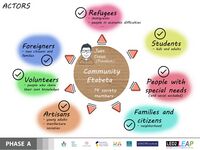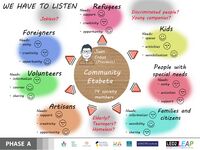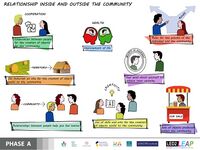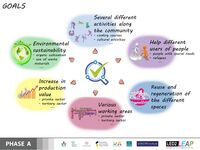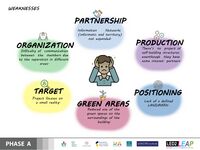LED2LEAP 2020 - Bologna Team 3
Jump to navigation
Jump to search
>>>back to working groups overview
Landscape Democracy Rationale
- This community is a challenge for the metropolitan city of Bologna, which has been buried behind little publicity or information.
Starting from the common principle that it is based on pillars:
- man
- health
- creativity
The cooperative has developed trying to connect abandoned spaces, in disuse and degradation of the urban periphery.
Location and scope
Phase A: Mapping your Community
Welcome to your community and its landscape
- Eta Beta is a non-profit cooperative formed by President Juan Crous and 14 other members to bring together all those people who have little voice in society in a community in the outskirts of Bologna.
Groups of actors and stakeholders in your community
- The main actors of the community are groups of students, volunteers and families who cooperate in various initiatives.
These include several sensitive categories, which however do not interact with each other and exclude new points of view.
Relationships between your actors and groups
- The community involves several groups for different activities:
- cooperation to create objects that are sold inside the company's workshops
- reuse of abandoned spaces through community work
- sale and involvement of the neighborhood through events
- contribute to feeling good, both physically and within society
Summary of your learnings from the transnational discussion panel on April 22
Since the presentation of phase A we have discovered new methods of thinking and development of international analyzes and ideas.
- From the Dublin team we noticed that their method of analysis is very much geared towards the sustainability of the intervention.
- From the Freising groups, on the other hand, we investigated new methods of graphing and analyzing the territory.
We were surprised by the diversification of representation.
Theory reflection
- Reflect on at least three readings from the first section 'Democratic Landscape Transformation
- You can choose references from our reading list or suggest others
- Scope: 250 words
References
- https://www.etabeta.coop/ Official website
- Direct or indirect communication with the association
- Company balance sheet
Phase B: Democratic Landscape Analysis and Assessment
* template coming
Phase C: Collaborative Visioning and Goal Setting
* template coming
Phase D: Collaborative Design, Transformation and Planning
* template coming
Phase E: Collaborative Design, Transformation and Planning
* template coming
= Phase E: Collaborative Evaluation and Future Agendas * template coming
Process Reflection
- Reflect in your intercultural and interdisciplinary team on the outcomes of your study
- Which limitations were you facing?
- What have you learnt from each other?
- What would you do differently next time?
- You can also use diagrams/visuals
- 250 words text



